SOUTHERN CONSERVATION AREA MOBILE VETERINARY UNIT AUGUST 2016 Prepared by Dr
SOUTHERN CONSERVATION AREA MOBILE VETERINARY UNIT AUGUST 2016
Prepared by Dr. Ndambiri Ephantus
Introduction
The month under review has been characterized by hot dry and dusty weather. Wild animals are observed every night moving from the Amboseli N.P. to the community area surrounding the park in search of foliage to supplement what the park is offering. In the mornings the animals move back to the Park seeking solace and water. This movement at times results in conflict leading to hostility towards wild animals from the community.
CASE#1 AN INJURED WILDEBEEST
Date attended: 23rd August 2016
Species: Wildebeest
Sex: Male
Age: Adult
Location: Amboseli N.P.
History
After being observed for four days with unimproving left hind limb lameness and losing body condition the Veterinary Unit was called in.
Immobilization, examination and treatment
The wildebeest was darted with 4mgs Etorphine and 50mgs Azaperone. The first dart was poorly placed because of the strong wind necessitating a second dart which was perfect. Induction took ten minutes. Animal assumed right lateral recumbence and was covered with a blind fold to limit sight stimulation and corneal injury.
The limb was palpated for any swelling and then manipulated from the hoof upward. It was noted to have a slight crepitus on the medial aspect of the genu joint rostrally. A little swelling and warmth were evident indicative of a chip fracture of the distal femur. This could have been caused by abrupt stiff strain on the joint either following sudden flight or during a fight with its counterpart. It was decided to be given a chance to live because it was bearing weight slightly on the limb reaching for water and foliage.
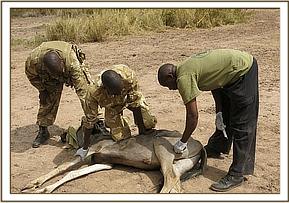

It was injected with 40mgs Dexamethasone and 20ml Catosal intramuscularly at different sites. Subcutaneously it was covered for endo- and ecto- parasite using 7mgs Ivermectin.
Reversal
It was revived with 12mgs Diprenorphine into the jugular vein. It was completely up in three minutes and ambulated away.
Prognosis
It was given guarded prognosis considering the presence of big predators within the area and that it could not easily salvage itself through flight. It will be monitored for any possible review after ten days.
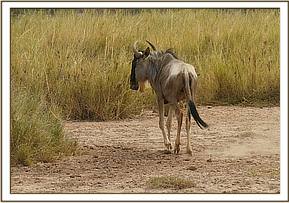
CASE #2 TREATMENT OF A SPEARED ELEPHANT
Date attended: 26th August 2016
Species: Elephant
Sex: Male
Age: Adult
Location: Kimana Sanctuary
History
It was reported to have a swelling on the right shoulder with dry discharge from the swelling apex causing slight lameness.
Immobilization, examination and treatment
The elephant was sedated using 14mgs Etorphine and 1000 I.U Hyaluronidase in 1.5ml dart propelled by Dan –Inject darting system. Induction took eight minutes and covered substantial distance because he was afraid and aware before darting. He assumed a dog sitting position but was pushed onto left recumbence by the help of a strap anchored on the vehicle and to the right tusk. Its right ear was used as a blind fold to cover the right eye. The trunk was immediately straightened and kept patent by the piece of stick across the rostral opening.
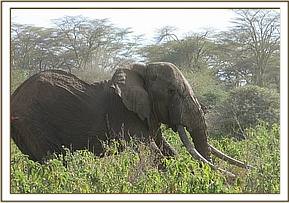

Due to shearing of muscles before and after darting the swelling burst open and started discharging tenacious pus. The pus pouch was about thirty centimeters deep and though septic it had no maggot invasion. This was due to a spear head which must have dropped out because no foreign body was recovered from the pouch.
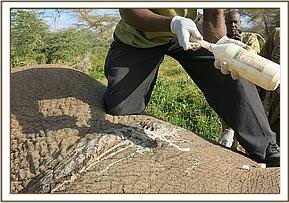

It was cleaned thoroughly with Hydrogen Peroxide and Iodine. Then 30000mgs Tetracycline was infiltrated into the pouch followed by Green Clay to enhance wound healing. Systemically it was injected with 40ml Catosal and 30000mgs Tetracycline into muscles at different sites to prevent development of septicemia. 50mgs Dexamethasone was injected to ease inflammation
Reversal
It was revived with 40mgs Naltrexone into the superficial ear vein after forty minutes since darting. It was on its ffet in one and half minutes energetically ambulated away.
Prognosis
It has a favorable prognosis because the injury was noted early before causing severe lameness and before septicemia setting in.
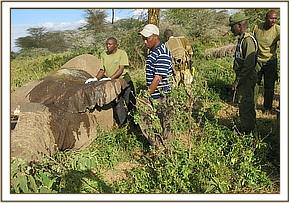

CASE #3 CHECK UP ON ELEPHANT TIM
Date attended: 27th August 2016
Species: Elephant - Tim
Sex: Male
Age: Adult
Location: Kimana Sanctuary
Health Inspection
This particular candidate is renowned for his long and heavy tusks hence under active monitoring after recently being treated for a spear injury. Tm had not been sighted for over a month then he resurfaced at Kimana Sanctuary in the company of three other males. All were found browsing on acacia shrubs headed for water at the nearby stream.
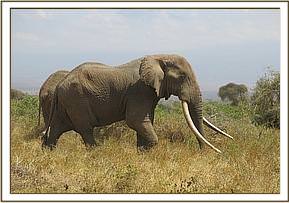

His health was impeccable with complete healing of the left ear base where the spear injury was. He was ambulating evenly and had no notable injury externally.
He will continue to be monitored until he can be collared so that he can be observed more accurately and on a daily basis.
CASE #4 TREATMENT OF A SPEARED ELEPHANT
Date attended: 29th August 2016
Species: Elephant
Sex: Female
Age: Adult
Location: Rombo Nalositi Area
History
This elephant was reported by Big Life rangers as being unable to move and with a wound on the left rump dorsally near spine. It was in the company of a daughter between one and two years old.
Immobilization, examination and treatment
For effective examination and treatment both mother and daughter had to be darted with the daughter immobilized first followed by the dam. The calf was sedated using 5mgs Etorphine and 500 I.U Hyaluronidase in 1.5ml dart propelled by Dan –Inject darting system. Induction took five minutes and she lay on left lateral recumbence about ten meters from the mother. The Dam was darted with 13mgs Etorphine and 1000 I.U. Hyaluronidase in 1.5cc dart. She went down in a dog sitting posture in seven minutes and was pushed on to left lateral recumbence with the help of rangers. Each trunk was kept patent by use of a piece of stick across the opening distally. The top most eyes were blinded using ear flaps.


The daughter had no noticeable injury superficially while her mother was dehydrated with sunken eyes and poor muscle cover. The wound was leading to the front just about ten centimeters under the skin and was seemingly due to a spear which did not lodge in the muscles but caused skin break. It was septic with tenacious pus. There was also an old healed wound on the right flank just behind the rib cage.
The septic wound was cleaned with Hydrogen Peroxide ensuring all pus suppurated then it was flushed with Iodine. It was liberally sprayed with Tetracycline wound spray and filled with green clay. It was covered systemically with 15000ml Amoxicillin and 40ml Catosal into muscles at different sites.
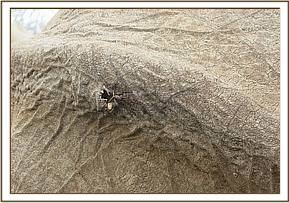

Reversal
Narcosis was reversed with 12mgs Diprenorphine into the ear vein of the calf first until signs of reversal were eminent then the mother was reversed with 80mgs Naltrexone mixed with 300mgs Doxapram into ear vein. The calf got up after 3minutes one minute earlier than the mother and walked about twenty meters before charging towards the mother where we were. The Unit retreated rapidly until she moved off to a safe distance.
The mother tried to get up twice failed so we supported her head with the strap on the right tusk and she got up. She walked away weakly and sluggish. She then assumed sternal recumbence and we left her to get up on her own under keen watch of the rangers.
Prognosis
The prognosis is guarded because of the poor body condition she was in. It was not definitively clear why she had such poor health while the daughter was very healthy.
CASE#5 POSTMORTEM OF AN ELEPHANT
Date attended: 30th August 2016
Species: Elephant
Sex: Female
Age: Adult
Location: Rombo Nalositi Area
History
The elephant female treated the previous day in a very poor condition died later that day after the treatment. Her baby kept vigil by her side.
Postmortem Report
A postmortem was done the following day and these were important observations made;
- She was on left lateral recumbence
- The two trophies (tusks) were picked by KWS Rombo PAC team for safe custody and onward transmission.
- Mucus membranes were very dry with sunken eyes. Hardly was there bleeding even during and after recovery of the tusks.
- The right flank skin scar was examined and so was the fresh injury on the left rump near the spine. Both were just intradermal and had not in any way reached the sub cutis.
- Bowels were filled largely with air with five balls in gastric pouch of ruminal contents. Mesenteric vessels were less congested and hardly any peritoneal fluid. Her omentum was devoid of fat tissue and membranous.
- There was little straw coloured pericardial fluid with Myocardium depicting different types of hemorrhages superficially. The heart was devoid of coronary fat and left ventricle myocardium had gelatinous material superficially. When cut the wall was very thick leaving very little room internally.
- Her dentition shown two fully grown molar meaning the calf she had could have been the first ever to calf
- No other important observation was made on other vital organs such as liver, spleen, kidneys and lungs
Conclusion
From ante-mortem examination she seemed to have had a long standing condition affecting her health performance. The flesh wound during treatment was ruled out as cause of her ill health and so was the scar during the postmortem. Her health depicted poor performance due to severe emaciation and dehydration. All these were supported by her failing heart which depicted congestive heart problem. She could not keep up with the pace of the others hence her isolation. She could not look for browse and water during the prevailing dry season thus her poor general body condition.

Cause of death
Tentatively the female elephant died because of cardiorespiratory embarrassment.
CALF
The female calf was not located on this particular day. Aerial support both from the David Sheldrick Wildlife Trust and Big Life mounted an all-day search in vain. Ground teams from Amboseli Mobile Vet Unit, Big Life, DSWT Voi and Maktau, KWS Rombo and Tsavo East were on standby just in case she was spotted to facilitate capture and adoption. Indications are that she could be heading to Kimana Sanctuary. Alternatively if she is not spotted in the next three days she could have been adopted by other herds.
CASE#6 TREATMENT OF A SPEARED ELEPHANT
Date attended: 31st August 2016
Species: Elephant
Sex: Male
Age: Adult
Location: Amboseli National Park
History
He was reported by IFAW walking with difficulties on his left hind limb towards a swamp from community area. Quick response was mounted and was found near the swamp.
Immobilization, examination and treatment
He was darted with 13mgs Etorphine and 1000 I.U. Hyaluronidase in 1.5cc dart. Induction took 11 minutes and he assumed right recumbence. His left eye was covered with left ear pinna.
The left knee was swollen and had an angry open wound covered with necrotic shreds and creamy pus. On the same limb at the rump area, there was a discharging penetrating wound. It was discharging serous fluid and had been caused by a spear approximately three days earlier. It was about 15 centimeters deep.
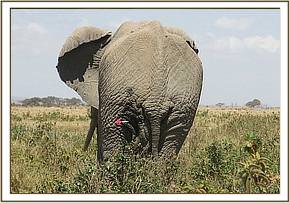

Both wounds were cleaned with Hydrogen Peroxide and Iodine. The penetrating wound was infiltrated with 7500mgs Amoxicillin and all were smeared with Green Clay to enhance healing. Both were then topically sprayed with Tetracycline wound spray. Systemically he was injected with 15000mgs Amoxicillin and 40ml Catosal into the muscles to cover against opportunistic bacterial pathogens. He was also injected with 50mgs Dexamethasone for inflammation.
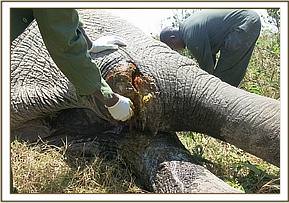

Reversal
He was revived with 36mgs Diprenorphine injected into the superficial ear vein. He was up in two minutes and ambulated slowly away.
Prognosis
He has a guarded prognosis because of the involvement of the joint tissue and the second injury on the rump
FAMILIARIZATION TOURS.
Following the transfer of the resident vet early this month, the new vet familiarized himself with a tour of the new environment and also met other stakeholders within the area.
16th-17th August: Reported to Amboseli Mobile Veterinary Unit base at Amboseli N.P.
18th August: Took over from the Vet at the Unit base
20th – 21st August; Went round the Amboseli National Park
22nd August: Visited Kimana Sanctuary Hqs and exchanged mobile numbers for vet assistance
23rd August: Attended Section Heads meeting and handing over of the out-going AD to in-coming AD Southern Conservation Area
24th August: Visited Loitoktok KWS Sub-station and exchanged contacts for any vet assistance
26th August: Visited Porini Camp and Lion Guardian camp and exchanged contacts
29th August: Visited KWS Rombo Station and exchanged contacts
Acknowledgements
I wish to acknowledge the generosity of David Sheldrick Wildlife Trust and associates towards conservation under which the Mobile Vet Unit thrives. All other stakeholders including KWS, communities, NGOs, private ranches/conservancies and other government agencies are also commended for their unwavering support. All these concerted efforts have ensured the Units success.






















